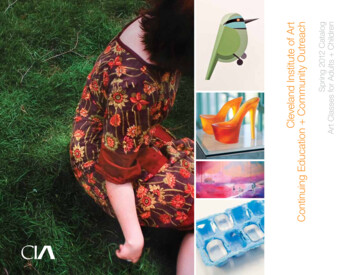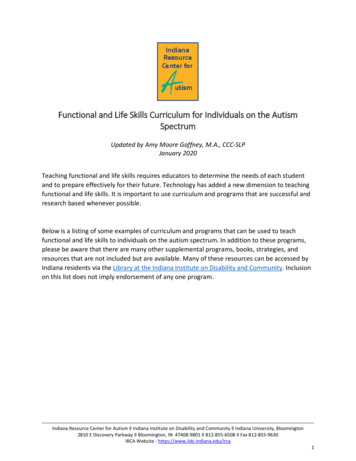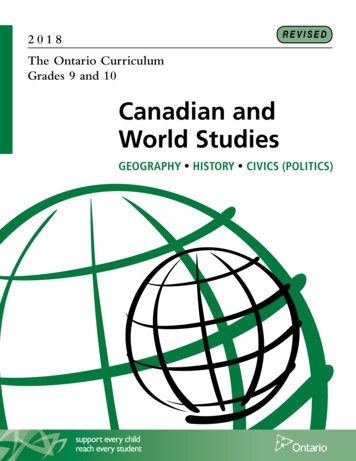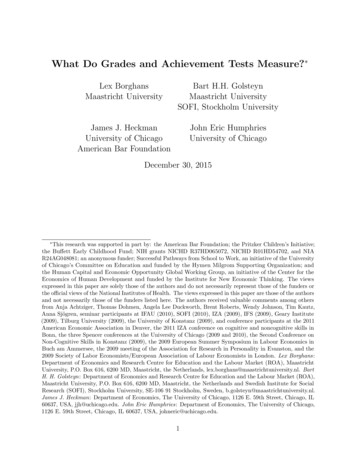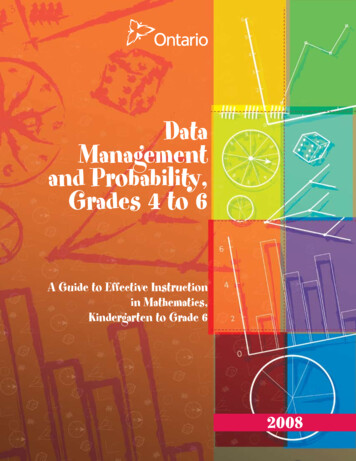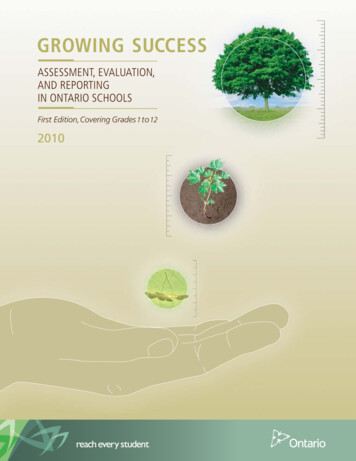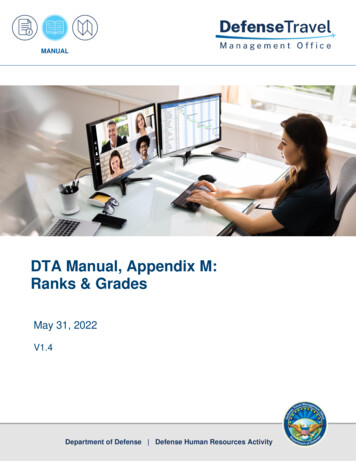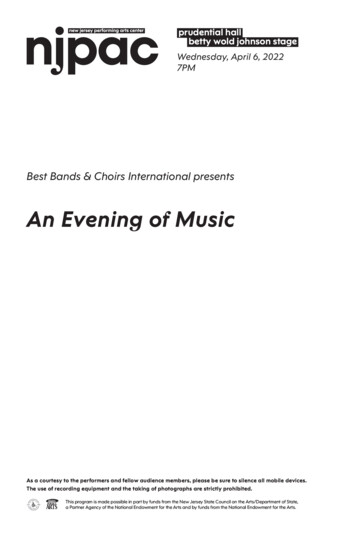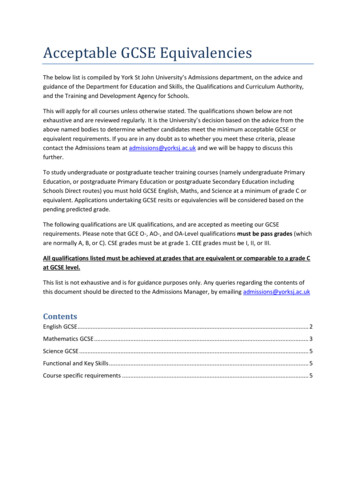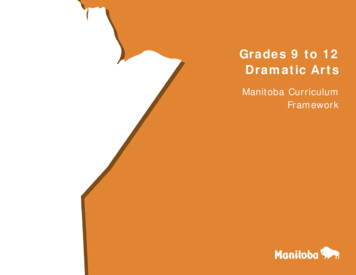
Transcription
Grades 9 to 12Dramatic ArtsManitoba CurriculumFramework
Gr ades 9 to 12Dr amat ic ArtsManitoba CurriculumFramework2015M a ni t o b a E d u c a t i o n a n d A d v a n c e d L e a r nin g
Manitoba Education and Advanced Learning Cataloguing in Publication DataGrades 9 to 12 dramatic arts [electronic resource] : Manitobacurriculum frameworkIncludes bibliographical references.ISBN: 978-0-7711-6085-11. Drama—Manitoba—Curricula.2. Drama—Study and teaching—Manitoba.3. Drama—Study and teaching (Secondary)—Manitoba.4. Arts—Manitoba—Curricula.5. Arts—Study and teaching—Manitoba.I. Manitoba. Manitoba Education and Advanced Learning.792.0712Copyright 2015, the Government of Manitoba, represented by the Minister ofEducation and Advanced Learning.Manitoba Education and Advanced LearningSchool Programs DivisionWinnipeg, Manitoba, CanadaEvery effort has been made to acknowledge original sources and to complywith copyright law. If cases are identified where this has not been done, pleasenotify Manitoba Education and Advanced Learning. Errors or omissions will becorrected in a future edition.All images found in this document are copyright protected and should notbe extracted, accessed, or reproduced for any purpose other than for theirintended educational use in this document.Any websites referenced in this document are subject to change. Educatorsare advised to preview and evaluate websites and online resources beforerecommending them for student use.Print copies of this document (stock number 80707) can be purchased fromthe Manitoba Learning Resource Centre (formerly the Manitoba Text BookBureau). Order online at www.mtbb.mb.ca .This resource is available on the Manitoba Education and Advanced Learningwebsite at www.edu.gov.mb.ca/k12/cur/arts/drama/index.html .Disponible en français.Un document pour le programme d’immersion française et un document pourle programme français sont également disponibles.Available in alternate formats upon request.
ground1Content2The Centre of the Butterfly13The Wings of the Butterfly13Essential Learning Areas15Recursive Learnings16Guide to Reading the Dramatic Arts Framework18Grades 9 to 12 Dramatic Arts LearningsOverview3What Is Dramatic Arts Education?3Why Is Dramatic Arts Education Important?3What Is Quality Dramatic Arts Education?6The Learning Lens6The Curriculum Lens8The Learning Environment Lens8The Assessment Lens9Dramatic Arts Education in Manitoba Schools10The Dramatic Arts Learning Landscape11The Dramatic Arts Framework12The Dramatic Arts Framework Butterfly12The Butterfly as Graphic Organizer12The Butterfly as ��R248DR–R350DR–R452Contentsiii
AppendixAppendix: Conceptual Framework for LearningGrowth in Dramatic Arts Educationiv5557Glossary69Bibliography75Grades 9 to 12 Dramatic Ar ts: Manitoba Curriculum Framework
AcknowledgementsManitoba Education and Advanced Learning gratefully acknowledges the contributions of the following individuals in the developmentof Grades 9 to 12 Dramatic Arts: Manitoba Curriculum Framework.Principal WriterContributing WritersDevelopment TeamPauline BroderickProfessor/InstructorFaculty of EducationUniversity of ManitobaJoe HalasArt ConsultantWinnipeg School DivisionWendy McCallumProfessorSchool of MusicBrandon UniversityJulie Mongeon-FerréProject Co-leader/ConsultantCurriculum Development and Implementation BranchBureau de l’éducation française DivisionFrancine MorinProfessor, Department HeadCurriculum, Teaching and LearningFaculty of EducationUniversity of ManitobaBeryl PetersProject Co-leader/ConsultantDevelopment UnitInstruction, Curriculum and Assessment BranchAmanda AlexanderTeacherSt. John’s-Ravenscourt SchoolIndependent SchoolsBarbara EngelTeacherJohn Taylor CollegiateSt. James-Assiniboia School DivisionAlain JacquesTeacherCollège Louis-RielDivision scolaire franco-manitobaineSusan KurbisTeacherMaples CollegiateSeven Oaks School DivisionAcknowledgementsv
Development Team(continued)Pilot/Review TeamviMarie-Claude McDonaldArts Education CoordinatorDivision scolaire franco-manitobaineIngrid PedersenArts Education CoordinatorLouis Riel School DivisionNancy PitcairnTeacherVincent Massey High SchoolBrandon School DivisionJey Thibedeau-SilverTeacherGarden City CollegiateSeven Oaks School DivisionJoël ChartierTeacherÉcole/Collège régional Gabrielle-RoyDivision scolaire franco-manitobainePhyllis FurkaloTeacherNorthlands Parkway CollegiateGarden Valley School DivisionJennifer GillespieTeacherMaples Collegiate InstituteSeven Oaks School DivisionPhilippe HabeckTeacherCollège Jeanne-SauvéLouis Riel School DivisionTanya HenryTeacherWest Kildonan CollegiateSeven Oaks School DivisionJohn KerrTeacherBalmoral Hall SchoolIndependent SchoolsPaul KrahnTeacherW. C. Miller CollegiateBorder Land School DivisionMarie-Claude McDonaldArts Education CoordinatorDivision scolaire franco-manitobaineVictoria McMahonTeacherGrant Park High SchoolWinnipeg School DivisionGrades 9 to 12 Dramatic Ar ts: Manitoba Curriculum Framework
Pilot/Review Team(continued)Nancy PitcairnTeacherVincent Massey High SchoolBrandon School DivisionKyllikki RuuTeacherOak Park High SchoolPembina Trails School DivisionBrett SchmallTeacherGreen Valley SchoolHanover School DivisionLisa VasconcelosTeacherElton CollegiateRolling River School DivisionSandy WhiteTeacherWestwood CollegiateSt. James-Assiniboia School DivisionTracey ZachariasTeacherFort Richmond CollegiatePembina Trails School DivisionLandscape PhotographerStan MilosevicWinnipegManitoba Education andAdvanced Learning StaffJean-Vianney AuclairAssistant Deputy MinisterBureau de l’éducation française DivisionCarole BilykCoordinatorDevelopment UnitInstruction, Curriculum and Assessment BranchLouise BoissonneaultCoordinatorDocument Production Services UnitEducational Resources BranchDarryl GervaisDirectorInstruction, Curriculum and Assessment BranchSchool Programs DivisionSusan LetkemannPublications EditorDocument Production Services UnitEducational Resources BranchGilbert MichaudDirectorCurriculum Development and Implementation BranchBureau de l’éducation française DivisionSchool Programs Division and Bureaude l’éducation française DivisionAcknowledgementsvii
Manitoba Education andAdvanced Learning StaffSchool Programs Division and Bureaude l’éducation française Division(continued)Julie Mongeon-FerréProject Co-leader/ConsultantCurriculum Development and Implementation BranchBureau de l’éducation française DivisionAileen NajduchAssistant Deputy MinisterSchool Programs DivisionBeryl PetersProject Co-leader/ConsultantDevelopment UnitInstruction, Curriculum and Assessment BranchDiana TurnerManagerDevelopment UnitInstruction, Curriculum and Assessment BranchLindsay WalkerDesktop PublisherDocument Production Services UnitEducational Resources Branch
IntroductionPurposeThe purpose of Grades 9 to 12 Dramatic Arts: ManitobaCurriculum Framework (the Dramatic Arts Framework) is toQQsupport, nurture, and inspire the learning growth of alldramatic arts learnersQQsupport the novice and inspire the veteran dramatic artseducatorQQprovide direction for learning design, assessment, andevaluationQQset out the philosophical and pedagogical foundations fordramatic arts learningQQarticulate a palette of possibilities for learning designQQpresent the four essential learning areas of the dramaticarts curriculumQQprovide guidelines for dramatic arts educationprogramming and implementation and for coursedevelopmentBackgroundIn 2003, Manitoba Education developed a draft positionstatement on The Arts in Education (Manitoba Educationand Youth) as an initial step in renewing provincialcurricula for the arts. The draft statement was distributedto education stakeholders, with an invitation to providefeedback about the proposed direction for curriculumrenewal. Responses were published in 2004 in Responsesto The Arts in Education Survey: Summary Report(Manitoba Education, Citizenship and Youth). Theresponses to The Arts in Education position statementguided subsequent development of arts curricula inManitoba.In January 2011, the Western and Northern CanadianProtocol for Collaboration in Education, Kindergartento Grade 12 (WNCP) prepared Guiding Principles forWNCP Curriculum Framework Projects in response to thesignificant changes in the ways people live and work intoday’s world. The Dramatic Arts Framework reflects theWNCP guiding principles that aim to meet the needs oftoday’s creative economies and societies.Introduction1
In September 2011, Manitoba Education published thefinalized versions of the Kindergarten to Grade 8 artseducation curriculum frameworks:QQKindergarten to Grade 8 Dance: Manitoba CurriculumFramework of OutcomesQQKindergarten to Grade 8 Drama: Manitoba CurriculumFramework of OutcomesQQKindergarten to Grade 8 Music: Manitoba CurriculumFramework of OutcomesQQKindergarten to Grade 8 Visual Arts: ManitobaCurriculum Framework of OutcomesIn September 2014, Manitoba Education and AdvancedLearning posted draft versions of the Grades 9 to 12curriculum frameworks for dance, dramatic arts, music,and visual arts education. The underlying philosophy of theKindergarten to Grade 8 arts education frameworks wasextended to the Grades 9 to 12 frameworks. Key commonfeatures include the four interconnected essential learningareas, the recursive learnings, and a learner-centred,socio-cultural, complexivist learning philosophy.2ContentThe Dramatic Arts Framework addresses the purpose,nature, and importance of quality dramatic arts educationin Manitoba schools from Grades 9 to 12. It explains theuse of the butterfly as a metaphor for learning within thedramatic arts learning landscape and for representing theinterconnected parts of the dramatic arts curriculum. Thecurriculum consists of four essential learning areas, whichare further elaborated by recursive learnings, and realizedthrough enacted learnings. Ideas for inquiry questionsare also included to support the enacted learnings. Theappendix, glossary, and bibliography provide furthersupport for the dramatic arts learnings.Grades 9 to 12 Dramatic Ar ts: Manitoba Curriculum Framework
OverviewWhat Is Dramatic Arts Education?Why Is Dramatic Arts Education Important?Dramatic arts education draws from a broad field ofdramatic arts practices that includeDramatic arts education develops important disciplinaryand cross-curricular competencies for learning andliving well together in an interconnected world. Researchindicates that well-designed dramatic arts educationcontributes to learning engagement, self-efficacy, and awide range of positive academic, social, and emotionaleffects. Dramatic arts education offers learners diverse,unique, and powerful ways of perceiving and makingmeaning about the world.skits, vaudeville, improvisation, theatre, musicals,collective theatre, routines, drama, docudrama, processoriented drama, political theatre, dance, carnival, buskers,puppets, mime, cultural theatre, story theatre, dramaacross the curriculum, mystery plays, comedy theatre,feminist theatre, theatre of the queer, classical theatre,Asian theatre such as Kabuki, children’s theatre, children’sfilm, children’s animation, and children’s live theatre,television, video, multimedia, performance art, chambertheatre, readers’ theatre, circus, scripted theatre, creativedramatics, agit prop, choral reading, opera, promenade,community theatre, pantomime, burlesque, reviews,spectacles, ceremony, pageants, rituals, street theatre,and a host of other forms. (Berry 2)Dramatic arts education is important because . . .1.The dramatic arts have intrinsic value.The dramatic arts are a vital, integral part of all humanexperience, culture, and history, and have expressedand enriched life since the beginning of time. Thedramatic arts help develop understanding of self andthe world. They profoundly engage body, mind, andspirit to communicate ideas and feelings that oftencannot be expressed by any other means.These practices offer multiple ways for learners to engagewith, connect with, and respond to their world throughvarious approaches and in diverse dramatic arts educationcontexts.Dramatic arts education is not just about learning thelanguage and practices of the dramatic arts, “it is aboutaddressing who we are as people, embracing difference,encountering numerous cultures, interacting andcollaborating with others, and inviting response” (Sansom215–216, referring to dance education, but also applicableto dramatic arts education).2.Dramatic arts education develops creative, critical,and ethical thinking.Creative processes, imagination, and innovationdeveloped through dramatic arts education areimportant for both artistic and everyday creativity.*Critical and creative thinking are uniquely positioned in*See Glossary.Overview3
dramatic arts education and are essential for learningin today’s world.repertoire of literacies needed to make andcommunicate meaning in diverse and evolvingcontexts. Ways of knowing in the dramatic arts areunique and powerful affordances* and resources formaking meaning that are not always possible throughother representational forms.Dramatic arts education provides space andopportunities for learners to explore and communicatecomplex ideas and emotions. Learning in thedramatic arts invites open-ended, emergent, anddialogic thinking. When learners seek possibilities,and envision and consider alternatives, they developcapacities for tolerating ambiguity and uncertainty.Learners become aware that questions have morethan one answer, that problems have multiple andsometimes unexpected solutions, and that there aremany ways to convey thoughts and ideas.In this shifting and complex world, literacies areinterconnected and codependent. Since all literaciescontribute to meaning making in different ways, it isimportant for learners to develop a diverse range ofliteracies, including artistic literacies, from which tochoose, depending on meaning-making needs andcontexts.Through the dramatic arts, learners critically observe,analyze, and act in the world. Critical thinking andreflection in dramatic arts education support thedevelopment of ethical thinking. By identifying anddiscussing ethical concepts and issues relatedto dramatic arts education, learners apply ethicalprinciples in a range of situations.3.A wide range of available literacies createsopportunities for learners to make meaningful literacychoices and to produce and consume new formsof texts by combining and recombining literacyresources.Drama/theatre literacy empowers learners with newmeaning-making resources and facilitates ways ofknowing in other forms, such as print-based literacyand numeracy.Dramatic arts education expands literacy choicesfor meaning making.4.In today’s multi-faceted world, literacy is defined asmuch more than the ability to read and write printtext. The texts that fill the world of today’s learnersare multi-modal and combine print, digital, physical,aural/oral, gestural, spatial, and visual texts, along withmany more.Drama/theatre is considered an expressive formof literacy with a unique set of language, skills,knowledge, and practices. The dramatic arts areimportant ways of knowing that expand learners’4Dramatic arts education contributes to identityconstruction.“The ability to define oneself rather than allowingothers to do it for us is one of the advantages offeredby the arts” (Canada Council for the Arts).Through dramatic arts education, learners haveprofound ways to define themselves and to constructpersonal and artistic identities. Developing artistic*See Glossary.Grades 9 to 12 Dramatic Ar ts: Manitoba Curriculum Framework
identity as a member of a dramatic arts communitypromotes a sense of belonging, unity, and acceptance.and learn to value others’ cultures, languages, andbeliefs. By engaging hearts and minds, the dramaticarts cultivate empathy and compassion for self andothers. Understanding how others think and feel isnecessary for intercultural awareness and competencyand for navigating and negotiating the complexitiesof the world. These qualities are key to developingleadership, social responsibility, and active democraticcitizenship.Learners explore, negotiate, and express personaland artistic identity through creating, consuming, andresponding to the dramatic arts. Learners examinethe ways that the dramatic arts reflect, shape, andcomment upon societal and cultural beliefs and issuesto develop understandings about social and culturalidentity.The dramatic arts offer individual and collectivemeans of self-expression—ways of illuminating theinner world and connecting to the outer, and ways ofexpressing the intangible.5.7.Dramatic arts education can improve and enhancesocial, emotional, physical, and spiritual well-beingand resilience. Well-being and resilience are vitalfor positive interpersonal relationships and learningengagement.Dramatic arts education develops communicationand collaboration competencies.The capacity for dramatic arts education to deeplyengage learners can enhance self-belief and selfesteem, and sustain perseverance and commitment.These qualities lead to improved school attendanceand successful learning.The dramatic arts provide unique and powerful toolsand processes for communication and collaborationthat transcend time, place, language, and culture.The collaborative nature of dramatic arts educationnurtures positive relationships and interactions.Learners are able to communicate emotion and ideasthrough an expansive and powerful repertoire ofdramatic arts language and practices.Using dramatic arts language and practices, alongwith information and communication technology,generates opportunities for learners to build anddeepen relationships with other learners, dramaticartists, and communities.6.Dramatic arts education develops interculturalcompetencies.Through dramatic arts education, learners developintercultural understandings as they engage withDramatic arts education is essential for well-being.The dramatic arts offer unique ways and safe spacesfor learners to examine and give voice to ideas andfeelings that cannot be expressed by words.8.Dramatic arts education supports sustainabledevelopment.Dramatic arts education offers opportunities forlearners to engage in issues of cultural, social,political, environmental, and economic forms ofsustainability.Dramatic arts education plays an important role inManitoba’s goals for sustainable development. Thedocument Education for a Sustainable Future: AOverview5
Resource for Curriculum Developers, Teachers, andAdministrators (Manitoba Education and Training)highlights community and culture, the economicviability of arts and cultural enterprises, and thepreservation and nurture of heritage and culture ascrucial sustainability issues. Cultural sustainabilityand social well-being are essential and integratedcomponents of an equitable quality of life and asustainable future for all Canadians.Social and personal competencies developedthrough dramatic arts education foster leadership,social responsibility, and environmental and globalawareness, which are crucial for the successful futureof sustainable development.9.Dramatic arts education is transformative learning.Learning in the dramatic arts has the potential to fostertransformative learning (Mezirow, “TransformativeLearning Theory” 19) and change the ways peopleview the world. Transformative learning draws onnew ways of knowing and being so that learners areempowered to challenge assumptions and developagency, identity, and self-direction for their lives.Arts-based processes have powerful transformativepotential “because they tap into embodied knowing,honor emotions, and create spaces for rehearsalfor action . . . . and imagining of alternative realities”(Butterwick and Lawrence 44).The transformative power of dramatic arts educationinspires learners to be leaders, innovators, andcommunity builders, and to address critical challengesof their times.610. Dramatic arts education fosters human flourishing.Dramatic arts education brings joy to self and others; itilluminates, deepens, and enriches learning and life.What Is Quality Dramatic Arts Education?Quality dramatic arts education is defined byunderstandings and beliefs about education informedby current research, theory, and practice. Theseunderstandings and beliefs are brought into focus throughthe lenses of learning, curriculum, learning environment,and assessment.The Learning LensThe learning lens highlights key understandings aboutlearning that inform quality dramatic arts educationpractice.LearningQQis an active, embodied, and social process ofconstructing meaningQQis recursive and shaped by the dynamic interaction ofprior knowledge and new experiencesQQis uniquely constructed according to personal, social,and cultural ways of knowingQQis personalized so that not everyone learns the samethings at the same timeQQis engaging when it is personal, relevant, and authenticQQis meaningful when learners have opportunities to reflecton and guide their own learningGrades 9 to 12 Dramatic Ar ts: Manitoba Curriculum Framework
QQQQis equitable and ethical when barriers* that limitlearning are understood and eliminatedcommunities of learners andeducatorsQQsituated contextsQQcurriculum structuresQQartistic and cultural communitiesQQdisciplinary ways of knowingand being(See adjacent illustration.)*Situated ContemuComTh enities of LearnersDramatic Arts LgQQt ur esxtsantorsd u cadEthe individual learnerCurriculum StrucmmuninerearQQArtistic and Cultural CodBtiesis shaped by relationships and interactionsbetween multiple nested levels (Davis andSumara, Complexity and Education 91) thatincludeDisciplinary Ways of Knowing aneinQQis both individual and group knowing so that individual,personal knowing is enfolded in and unfolded fromcollective knowing and experience (Davis andSumara, Complexity and Education 65)Barriers, biases, and power dynamics that limit prospects for learning may berelated to “sex, sexual orientation, gender identity, gender expression, race, ethnicorigin, religion, socio-economic background, physical or mental ability, or otherfactors” (Ontario Ministry of Education, Equity and Inclusive Education in OntarioSchools 6).Overview7
The Curriculum LensThe curriculum lens highlights essential aspects of qualitydramatic arts education that are illuminated through 13recursive learnings. Grades 9 to 12 recursive dramaticarts learnings are developed, recombined, elaborated,and transformed across novel and varied contexts so thatlearning becomes more sophisticated, more complex,deeper, and broader with time and new experiences.Recursive learning is more than repetition, iteration,accumulation, or the notion of a spiral curriculum. Theword recursive comes from the Latin verb recurrere, whichmeans “to run back” or “to return.” Through the processof returning and reflecting back on previous learning—“asecond looking—transformation, growth, developmentoccur” (Doll).Recursive learnings in the Dramatic Arts FrameworkQQQQQQ8focus on why dramatic arts learning is important, whatunderstandings and meanings dramatic arts languageand practices can communicate, what the dramatic artscan reveal about culture and identity, and what purposeand meaning drama/theatre have for individuals andcommunitiesbuild on prior dramatic arts learning in a reflective,recursive process so that new possibilities emerge andunderstandings and relationships grow over time andthrough experienceare sufficiently rich and substantive to generate deepconceptual understanding and learningQQafford a diverse and broad range of dramatic artsexperiences, participatory approaches, and ways ofthinking about, knowing, interpreting, responding to, andrepresenting the dramatic artsQQafford opportunities for transformative learningQQconnect to the wider dramatic and other artscommunitiesQQare integrated across essential learning areas to developconcepts and skills with meaning, coherence, depth, andcompetencyQQmay be assessed and evaluated using the ConceptualFramework for Learning Growth in Dramatic ArtsEducation (see Appendix)The Learning Environment LensQuality dramatic arts learning takes place in diverseenvironments that include physical, pedagogical, andsocial/cultural spaces in which learners and teachers learnand live well together.Physical spacesQQare safe, healthy, and appropriateQQhave sufficient material, structural, and technologicalresourcesPedagogical spacesQQare safe environments for risk takingQQinclude opportunities to explore creativity, imagination,flexibility, ambiguity, uncertainty, and student choiceGrades 9 to 12 Dramatic Ar ts: Manitoba Curriculum Framework
QQinclude multiple approaches to dramatic arts educationThe Assessment LensQQprovide learners with opportunities to inquire, question,dialogue, analyze, interpret, reflect, evaluate, andconstruct and share meaning through multipleperspectivesAssessment as part of teaching and learning is essentialto quality dramatic arts education. Assessment enhancesteaching and learning when it is designed toQQinclude collaborative, diverse knowledge building as itworks in the world (WNCP 9)QQinclude purposeful assessment for, as, and of learning(Earl, Katz, and WNCP)QQrequire sufficient time to explore all areas of the dramaticarts curriculum in substantive waysQQensure that assessment as and for learning is timely,ongoing, and central to all dramatic arts learningQQensure that assessment of learning is based on best andrecent learners’ work and on most consistent patternsof learning over time, using shared and/or co-createdcriteriaQQbe equitable, fair, transparent, and clearly communicatedQQbe meaningful and congruent with curricular and learninggoalsQQenable learners to construct and co-construct individualand collaborative learning goals and criteria forassessmentQQprovide learners with multiple and various opportunitiesand ways to demonstrate learningQQbe varied and include a broad range of assessment toolsand strategies (e.g., portfolios, recordings, interviews,journals, logs, conversations, observations, products,performances)QQencourage rather than limit artistic and creativedevelopmentSocial/cultural spacesQQrespect and value the diversity of all learners and allways of knowingQQsupport the emotional and social well-being of alllearnersQQpromote interaction, collaboration, and a sense ofcommunityQQvalue the individual and collective voiceQQsupport positive human relationshipsQQensure equitable and ethical learningOverview9
Dramatic Arts Education in Manitoba SchoolsManitoba offers a distinct framework for four artseducation disciplines: dance, dramatic arts, music, andvisual arts. Schools have the flexibility to offer the numberand combination of arts courses appropriate for theirlocal context, resources, and needs. The number of artsdisciplines and courses offered in a school will depend onavailable resources, allocated instructional time, staffing,and the arts implementation approach used in the school.The Dramatic Arts Framework provides flexibility forimplementation of a variety of dramatic arts educationcourses, strands, and approaches. Schools may offer artsdisciplines individually, in combination with each other,and/or integrated with other subject areas.Full and half credits in dramatic arts education are basedon full implementation of the Dramatic Arts Framework.The Dramatic Arts Framework is considered fullyimplemented only if all four essential learning areas areexplored in comprehensive, substantial, and interconnectedways. The balance and weighting of the four essentiallearning areas are flexible and depend on the focus andsituated context of each dramatic arts education course.Further information about course codes and credits can befound in the Subject Table Handbook (Manitoba Educationand Advanced Learning) and on the Manitoba DramaticArts Education website.Specialist education, pre-service and in-service education,and other professional learning opportunities are importantfor quality arts education implementation.Manitoba students can meet optional graduation creditrequirements by taking arts education courses designedusing the Grades 9 to 12 Dramatic Arts Framework. TheConceptual Framework for Learning Growth in DramaticArts Education (see Appendix) may be used to developdramatic arts courses, to plan for and assess learning indramatic arts education, and to distinguish course creditsfor each grade.10Grades 9 to 12 Dramatic Ar ts: Manitoba Curriculum Framework
The Dramatic Arts Learning LandscapeIn the Dramatic Arts Framework, the landscape metaphoris used to convey the understanding that learning isdynamic and always in the process of being constructed.New ways of thinking about curriculum involve ashift in the images we use, away from knowledge picturedas fragmented pieces put together, one piece at a time,in a linear fashion on an assembly line, to an image ofknowledge as a complex organic network organized intoliving fields, territories or “landscapes.” (WNCP 6)*Dramatic arts education in Manitoba is conceived as alearning landscape that represents a relational spaceof pedagogical possibility. In this space, the learner inrelationship with other learners, educators, Elders, and thelarger dramatic arts community interact and learn togetherin the dynamic, complex, living field of the dramatic arts.Knowing in the landscape of the dramatic arts “requires anetwork of connections linking the individual’s location inthe landscape to the larger space” (WNCP 20).The dramatic arts landscape provides multiple locationsfor diverse learners to enter, and offers varioustrajectories along which to journey and to continue lifelongtransformative travels.*Landscape Metaphor and ImageThe Manitoba landscape photograph that a
are advised to preview and evaluate websites and online resources before recommending them for student use. Print copies of this document (stock number 80707) can be purchased from the Manitoba Learning Resource Centre (formerly the Manitoba Text Book Bureau). Order online at www.mtbb.mb.ca .

